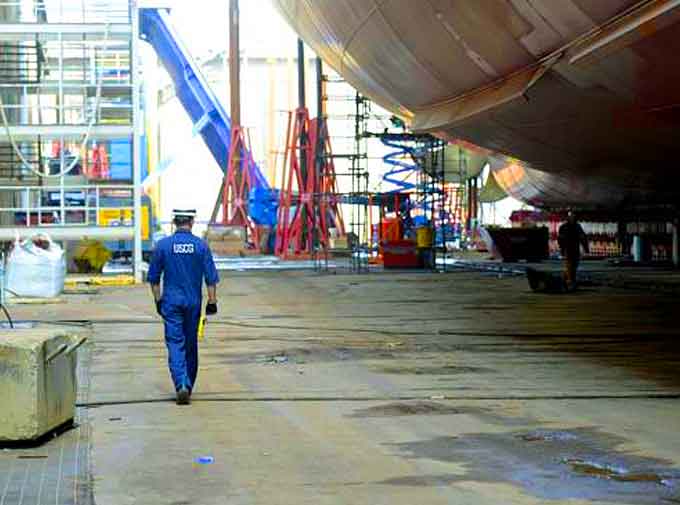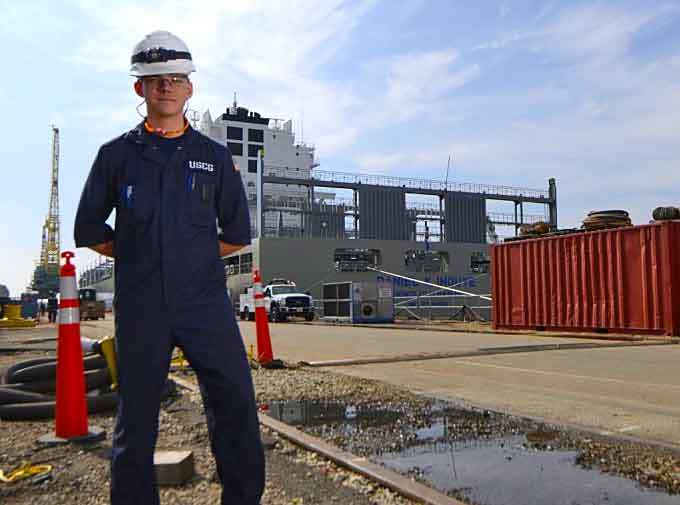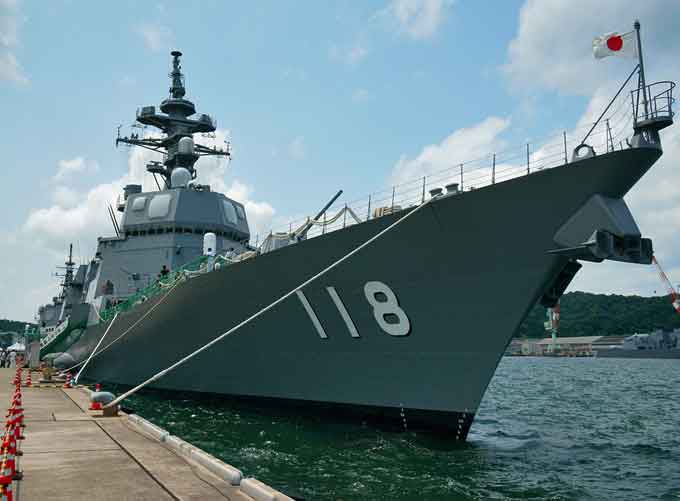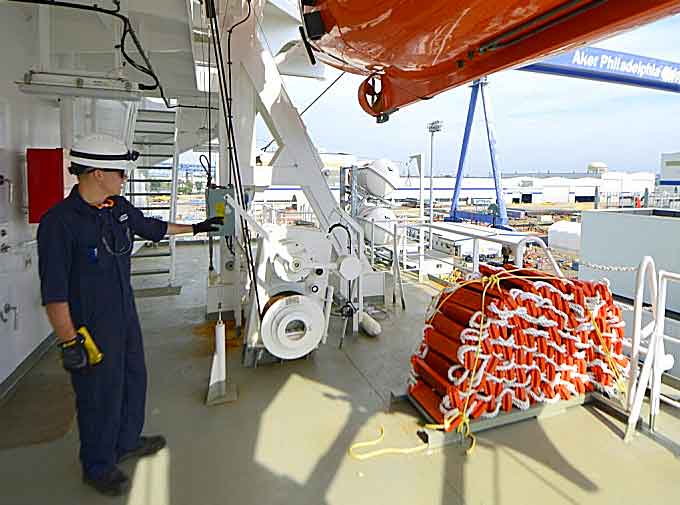
By Petty Officer 1st Class Seth Johnson, U.S. Coast Guard District 5 PADET Atlantic City
The Coast Guard is known for saving lives at sea, but did you know the service plays a huge role in the economy, too?
As a regulatory entity, the Coast Guard conducts marine inspections on vessels entering United States ports to make sure the vessels do not pose a safety, security, or environmental threat to the country.

With 90% of U.S. imports and exports entering or exiting the country by ship, these inspections ensure there is fuel at the gas station, food in the store and presents at birthday parties.
But even before a ship ever gets in the water, the Coast Guard is behind the scenes working to make it ready for sea.
Coast Guard marine inspectors work in tandem with ship builders in the United States to ensure the vessels are both safe for the workers and for operation in the maritime environment.
In fact, they are executing this mission in Philadelphia, where workers are constructing the largest container ships ever built in the United States right now for Honolulu-based Matson Navigation Company.
As a ship is built, like the 850-foot Daniel K. Inouye in Philadelphia Shipyards, the Coast Guard and the industry members work together.

They review architectural plans for the ship, monitor the laying of its keel, and observe the installation of lifesaving and engineering systems.
These efforts ensure a safe working environment for mariners and validate the integrity of the vessel.
“For the Coast Guard, ship construction like this in the United States gives us the opportunity to work with the maritime industry members,” said Lt. Cmdr. Jennifer Doherty, Coast Guard Sector Delaware Bay Chief of Inspections.
“The added benefit of the Coast Guard beyond building relations with American shipbuilders is that it gives us an opportunity to train our inspectors during the process of ship construction, which will benefit them throughout their prevention career.”
(Learn More. Courtesy of the U.S. Coast Guard and YouTube. Posted on Sep 28, 2017.)
Doherty, who oversees the team of Coast Guard marine inspectors who evaluate safety and security of ships throughout southern New Jersey, Delaware and eastern Pennsylvania, says that involving the Coast Guard ensures the safety of life at sea for workers but also that of the ports and waterways of the United States by keeping them clean from pollution and unobstructed.

Doherty says the having the Daniel K. Inouye built nearby has a local benefit as well.
“Building this ship in Philadelphia is a huge deal for the surrounding region,” said Doherty.
“When ships are built here it gives life to the shipyard, local area and maritime community.”
Lt. j.g. Ryan Thomas, a marine inspector at Coast Guard Sector Delaware Bay, who has been working on the project since February, says that being involved in inspections and review process during the building phase of a ship is not only interesting but educational.

Thomas says learning about the different systems of a ship during its construction have contributed to his growth as a marine inspector and he feels a sense of pride in helping to make a ship safer, but also as a native resident of Hawaii, he knows how important it is for commerce to move safely through American ports.
Thomas says that much of what Coast Guard inspectors interact with during ship construction are the lifesaving and emergency systems aboard a ship.
Things like rescue equipment, propulsion engines, steering systems, navigation equipment, electrical and fuel systems are some of the aspects inspectors focus on to ensure the ship meets the Coast Guard standard before making its way to full operations.
(See Coast Guard inspectors watching the Energy Atlantic crew conduct various shipboard operations for its first inspection before entering the United States, Port Arthur, Texas. Courtesy of U.S. Coast Guard adn YouTube. Posted on Jan 12, 2016.)
On a day-to-day basis, Coast Guard inspectors work with the ship builder, the shipping company and in the case of the Daniel K. Inouye, the international registrar and classification society.
Through their oversight and teamwork, all parties come together to develop a ship that meets standards for operation not only in the U.S., but also around the world, which leads to a safer situation for everyone, Ryan says.


















The Coast Guard recently announced its Maritime Commerce Strategic Outlook, which is the service’s long-term vision to support and grow maritime commerce in the U.S.
“Maritime commerce accounts for $4.6 trillion in annual economic activity; this strategy emphasizes the critical need for a ready, relevant, and responsive Coast Guard that maximizes America’s economic prosperity through the maritime domain,” said Coast Guard Vice Adm. Daniel Abel, deputy commandant for operations.
“The Coast Guard has the enduring responsibility to safeguard the Marine Transportation System (MTS) and promote the uninterrupted flow of maritime commerce.”
“This duty is becoming more challenging because the complexity of the maritime environment is rising due to emerging technologies, automation, interconnectivity, robotics, and networked systems.”
“These factors produce a system that is highly efficient and interdependent yet susceptible to disruption.”
“Any disruption – even a brief interruption – to America’s MTS has the potential for damaging effects to the nation’s economy and national security,” said Abel.
(Courtesy of dvidshub. Posted on Oct 15, 2018.)
The strategy includes three lines of effort:
Facilitating Lawful Trade and Travel on Secure Waterways
Modernizing Aids to Navigation and Mariner Information Systems, and
Transforming Workforce Capacity and Partnerships
“As the lead federal agency protecting our nation’s Marine Transportation System and the primary regulator of the maritime shipping industry, the Coast Guard advances American prosperity by safeguarding ports and waterways and ensuring unrestricted and unimpeded trade and travel through America’s waterways,” added Abel.
To support this vision, the Coast Guard will accelerate integration of modern navigation systems into an existing network of buoys and beacons.
“American economic global competitiveness depends on a state-of-the-art intermodal ports and waterways network,” said Abel.
Additionally, the Coast Guard will improve and enhance relationships with the maritime community, leverage bilateral and multilateral relationships, improve international standards and guidelines, and continue to work with state and local governments to ensure vessels are subject to consistent standards, while locally collaborating on protecting and preserving U.S. waters.
To Learn More, the Maritime Commerce Strategic Outlook is available at http://www.dco.uscg.mil/commerce.
Learn More…